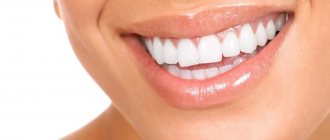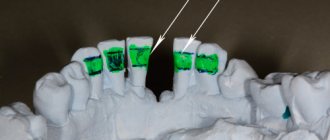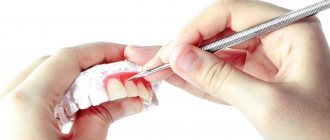The innovative non-invasive technique Digital Smile Design (DSD), developed by the world's leading specialist in the field of aesthetic dentistry, Christian Kochman, and successfully used by our dentists, helps to select the shape of the teeth, the color of the enamel and virtually simulate a smile that meets the aesthetic, emotional, and functional needs of the patient. Computer design of the dentition allows you not only to see the final result at the stage of planning restoration measures, but also to try on your future smile.
What problems does Digital Smile Design solve?
Ideally, creating a beautiful smile involves a collaborative effort between the dentist, dental technician, and patient. However, the patient’s opinion often fades into the background in this process, although it is he who is interested in the aesthetic result. It is not so rare that after installing veneers, crowns, bridges, the doctor is satisfied with the result, but the patient is not. The problem is that he created his ideal smile in his imagination (for example, he spied it in a glossy magazine), and the doctor had slightly different ideas about the beauty of his teeth.
DSD digital smile design technology allowed the patient to actively participate in the process along with the doctor and technician. Now the dentist can use a computer program to model the ideal dentition and create a physical demo model of new teeth, which the patient tries on in the same way as a new suit or dress. Thus, the process of restoration or correction of teeth becomes completely predictable and controlled by the patient. DSD dentistry also solves problems related to functionality:
- allows you to adjust the density of teeth in a row;
- improve bite;
- normalize enamel abrasion.
Patient approved smile design
Some clinics offer the client to put on a demo model of a new set of teeth and read his favorite poems. As experts say, a static photo does not give the desired effect, since it does not convey the features of articulation. The process is recorded on video, and the patient watches it and evaluates his smile. If the result is in doubt, the model is adjusted.
What are veneers and when are they installed?
A veneer is a thin covering of a tooth made of ceramic or composite.
It covers the front and sides of the tooth and covers the cutting edge. The purpose of the veneer is to hide visual defects of the tooth, give it the correct shape and make it whiter. The plates replace the top layer of enamel and correct aesthetic defects, which is why they are also called microprostheses. Such onlays are installed on teeth in the smile area, usually central and lateral incisors, canines and premolars. With veneers you can:
- Hide small chips and cracks in the enamel.
- Fill wide gaps between teeth.
- Correct non-critical shape defects and make the surface smooth.
- Improve color, hide stains on enamel and darkened fillings.
Important condition:
Veneers are installed only on healthy teeth. If there are caries or other pathologies, the doctor first eliminates them and only then corrects aesthetic defects.
When did digital smile design appear?
DSD dentistry is not just a technology, but a whole concept. It was developed by a talented dental technician, odontologist from Brazil Christian Coachman. The creation of the concept in 2007 has made Christian one of the most sought-after specialists in the field of dental modeling.
According to him, in practice, he was faced with the fact that many demanding patients, when visiting dentistry, wanted not only to solve functional problems in the oral cavity, but also to gain natural beautiful smiles that would correspond to their physiological characteristics and emphasize individuality and charisma.
Kochman developed the DSD protocol for dentists - a sequence of actions for modeling a future smile. Now he travels with lectures all over the world, in 2011 he visited Russia for the first time.
Christian Kochman has many followers, in particular, some dentistry in Russia combines two modern treatment systems - DSD and neuromuscular. This allows you to create a beautiful smile, restore proper breathing, posture and chewing functions.
What are ceramic veneers
Dental ceramics have characteristics as close as possible to tooth enamel. This is a durable material that transmits light and does not fade over time. Teeth with this coating look natural.
There are two main types of porcelain veneers:
- Porcelain. These plates have perfect aesthetics. If the shade is chosen correctly, teeth with such overlays cannot be distinguished from teeth with natural enamel.
- Zirconium. These are especially durable veneers with a zirconium dioxide frame and a ceramic coating. Zirconium plates are superior to porcelain plates in strength, but inferior to them in aesthetics. They are usually installed on the 4th and 5th chewing teeth if they fall within the smile zone. Or if the patient wants it. Only zirconium onlays can withstand the chewing load.
The essence of digital smile design concept
The concept is based on an analysis of the patient’s facial proportions and dental structure using a pre-made series of high-quality digital photos and videos. The doctor identifies the relationship between teeth, gums, lips, smiles and facial features, facial expressions in various emotional situations.
In order to engage in smile design in dentistry, you need to have artistic vision and have the skills to work with special software. According to Christian Kochman, each individual digital smile design can be clearly visualized and enhanced with the patient's ideas.
Veneers and Lumineers - what's the difference?
Lumineers or Lumineers™ are a patented name for ultra-thin veneers that are 0.2mm thick. The patent belongs to the American company DenMat. Lumineers, like other types of ultraneers, can only be installed on teeth of a uniform white color with a perfectly smooth surface. The plates are so thin and transparent that they are not able to mask pronounced stains on the enamel or darkened fillings. They will also not be able to correct tooth shape defects. Therefore, lumineers and their analogs are used in aesthetic dentistry less often than classic veneers.
Photo and video materials
During the examination and consultation, the doctor asks the patient in detail what result he wants to get. In some cases, the patient simply needs to model the front teeth when smiling, taking into account the shape, size, and shade. In other cases, it is necessary to restore chewing functions - insert missing teeth, correct the bite.
An important tool in DSD dentistry is photography and video recording of the patient’s face from various angles, as well as the oral cavity (dentition). They are performed using high-quality equipment, which allows obtaining materials in high resolution.
Additionally, the doctor takes impressions of the jaws. They are scanned, and the resulting images are sent to the dentist’s work computer. Advanced clinics have the latest equipment that allows you to do without impressions at all - the doctor scans the oral cavity with a compact camera, immediately obtaining a digital image.
If the doctor has to work on functional problems (for example, installing crowns or bridges on implants), X-rays and computed tomography are included in the diagnosis. If it is necessary to correct the amplitude of movement of the lower jaw, an articulator is used. Using these materials, the doctor receives a complete understanding of the structure of the jaw bone, the location of nerves and blood vessels, and the functioning of the joint.
How durable are porcelain veneers?
Microprostheses made of pressed ceramics are almost as strong as tooth enamel, and zirconium ones are even stronger. If the doctor has done a high-quality job - there are no voids left between the surface and the veneer, the edge of the veneer near the gum is perfectly adjusted and there is no “step” - the tooth is reliably protected from bacteria and external irritants. Plus, materials for fixing veneers contain fluoride and other minerals that strengthen tooth enamel.
How to Create a DSD Digital Smile Design
The principles of digital 3D dentistry have been actively used for more than 10 years to create anatomically accurate dental orthopedic structures. A computer program for DSD dentistry combines all photo and video materials into a single 3D model. The doctor works with it, shaping the appearance of the dentition.
Simulation takes on average 1 hour. The doctor, in the presence of the patient, corrects the shape of the teeth and the width of the interdental spaces. The program takes into account the proportions of the face, the characteristics of the bite, the movement of facial muscles in various emotional states of the patient, the position of the lips when smiling and many other anatomical parameters. The need to restore teeth with crowns and dentures is also taken into account.
Prices
Each method of aesthetic smile restoration has a different cost.
| Procedure | Cost, rub. |
| Professional cleaning | 2000-4000 |
| Remineralization | 1000-5000 |
| Whitening | 10000-25000 |
| Bracket systems | 20000-200000 |
| Veneers, lumineers (per 1 piece) | 15000-80000 |
| Mouthguards | 10000-30000 |
| Rhinestones | 1000-5000 |
| Skyes | 15000-60000 |
| DSD modeling (consultation + wax model) | 6000-12000 |
The exact price depends on several factors - the type and quality of materials, the type of clinic and qualifications of the specialist, the region of location, etc.
Can I try on a new smile?
The undoubted advantage of “Digital Smile Design” is the ability to test drive new teeth. In a dental laboratory, a silicone onlay is made using a 3D printer using a digital model, which accurately reproduces the updated teeth. The dentist invites the patient for a fitting, takes photos and videos, which can be used to evaluate the future result “in action.”
The patient not only visually evaluates his renewed face, but also tries how comfortable it is to talk and smile with new teeth. At the slightest inconvenience, changes are made to the model.
Frequently asked questions about veneers
What is better: veneers or restoration?
Veneers are orthopedic structures; unlike restorations, they are not used to restore destroyed and damaged teeth. These are different areas of aesthetic dentistry to solve different problems.
What is better - veneer or crown?
A veneer is installed when you need to make an entire healthy tooth beautiful without critical defects. A crown is used when a tooth is significantly damaged or its shape is so irregular that it cannot be corrected with a thin veneer. As in the previous case, these designs solve different dental problems.
How a restoration is made
When the model is finally approved, the laboratory begins to manufacture the restoration itself - prosthesis, veneer, crown. For this purpose, automatic CAD/CAM equipment is used, which produces orthopedic structures exactly according to the digital 3D model. Then the patient is invited to the installation and the dentition is corrected directly in the oral cavity. As a result, a person in reality receives the same smile that he had previously seen on the screen and tried on in the form of a silicone overlay.
Reviews
A lot of people have already used the services of aesthetic dentistry and become the owners of an ideal appearance.
We invite everyone to share their experience in creating a flawless look in the comments to this article.
If you find an error, please select a piece of text and press Ctrl+Enter.
Tags fixed prosthetics prosthetics
Did you like the article? stay tuned
Previous article
Optragate in dentistry – easy for the specialist and comfortable for the patient
Next article
Attitude of patients and specialists to amalgam in modern dentistry
First appointment with an orthopedic dentist.
First, you will have a full consultation - a survey, examination, analysis of complaints and analysis of the image. To start working on your smile, the doctor will do the following:
- Studio-quality portrait photographs using a special orthopedic protocol. This is a full-face photo, profile, with and without a smile, as well as a three-quarter turn of the head.
- Digital impression of teeth using an intraoral scanner. This is a small camera that takes high-resolution photographs of your teeth and builds a three-dimensional model of your jaws on a monitor.
- Intraoral photographs of teeth
How much does computer smile modeling cost?
It is worth noting that this type of creation of prostheses increases the cost of overall treatment, and modeling is not available in every clinic. However, many dentists are able to competently build a pricing policy in such a way as to minimize the cost of additional manipulations and equipment used. That is, in one clinic a patient may be charged an additional 10-15 thousand rubles for computer modeling of a smile. And in some places it is already included in the turnkey price and increases the final price of the prosthesis by only 1000-2000 rubles, or does not change it at all.
Patient Questions
QUESTION: I read about trying on a smile on a computer and wanted to clarify whether it is possible to do this if you only need 2 veneers? I have a gap between my front teeth and would like to somehow see the result in advance. And then suddenly I don’t like what the doctor does. Elena
ANSWER: Hello, Elena. Yes, computer smile modeling can be used for any number of necessary prostheses - be it 1-2 veneers or a whole complex for the front teeth. This concept really allows you to “try on” a new smile virtually - the doctor will show suitable options on the computer screen, and you will choose the one you like best. You can also select the color of the veneers so that it matches perfectly with the adjacent teeth and meets your expectations.
- Haug S. Correct modeling, 2006.
Author: Sambuev B. S. (Thank you for your help in writing the article and the information provided)
Stages of computer modeling and prosthetics
The process of dental restoration includes several stages that follow one after another. Let's look at them further and tell you when computer smile modeling is used and what initial data is needed for it.
Taking impressions or 3D scanning of the oral cavity
Now computerization can accompany the prosthetics process from start to finish. For example, dentists often abandon the usual casts or impressions of the dentition and use digital “casts” (using a 3D oral scanner).
But the usual physical impressions can also be used. True, in this case you will have to transfer them to the laboratory, make a plaster model1 and scan it - in order to create a digital version for its correction in Digital Smile Design. This route takes longer (2-7 days).
Photo and video session, assessment of bite parameters
Photographs (as well as short videos) are taken in order to evaluate the patient’s smile parameters, their relationship with other facial parameters, and also to understand how the facial muscles work. Filming is carried out when the patient is smiling, calm or deliberately “angry”, when he speaks or is silent. All photos and videos, and there can be several dozen of them, are loaded into the program and combined with digital impressions.
Also at this stage, the dentist uses various jaw movement analyzers (articulators, HIP plane analyzer, face bows). After all, in a future prosthesis, not only beauty is important, but also how it will relate to the existing bite.
Virtual smile modeling
All received data (imprints, photos, etc.) are entered into a computer smile modeling program. Then the parameters are processed, combined, and a three-dimensional projection is displayed on the screen that fully corresponds to the patient’s natural dentition. Next, adjustments are made to improve your smile. Moreover, you can immediately make several options for a new smile - with different shapes or heights, widths of teeth, with different shades of enamel, for example. And then the best option is selected, both from the dentist’s point of view and based on the patient’s wishes.
By the way, such a virtual projection can be combined with digital computed tomography of the patient and begin to develop a prosthesis, incl. and for placement on implants. Popular programs for creating prostheses are CAD/CAM systems CEREC and inLab from Dentsply Sirona, NobelProcera from Nobel Biocare.
Wax modeling and fitting of the prosthesis blank
In some cases, patients who need veneers, extended bridges or removable orthopedic structures should go through one more stage - fitting of the prosthesis blank. This is necessary to assess the comfort of the new teeth and their relationship with the neighboring ones. Here, after developing a model, the dental technician makes a “trial” prosthesis (from silicone, plastic, etc.), and then attaches it to a wax model, after which he hands it over to the orthopedic dentist, who tries it on the patient. If necessary, adjustments are made and the layout is sent back to the laboratory.
Creation of the prosthesis and its final installation
The approved version of the prosthesis goes through all stages of manufacturing - milling on a robotic machine, baking, glazing, polishing, etc. The production technology depends on the type of prosthesis, the properties of the material and its volume, which is needed to create each specific structure.
Previously, all production machines were manually adjusted by a person, using measurements also taken by hand. Therefore, there was no need to talk about accuracy, especially the first time. Today, dental devices (namely CAD/CAM systems) are configured largely automatically, in accordance with the parameters set by the computer. Therefore, inaccuracies and human errors are excluded here.
Today, dental crowns, bridges and the thinnest veneers are cut automatically by machines - quickly and the first time. As a result, the doctor simply fixes the prosthetic structure, without first trying it on and subsequent adjustment.










